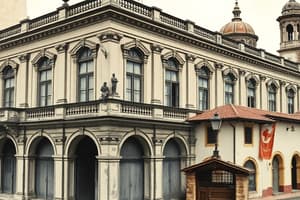Podcast
Questions and Answers
What were Filipino builders referred to during the Spanish era?
What were Filipino builders referred to during the Spanish era?
Maestro de Obras
Which structure was designed by Jesuit priest Antonio Sedeno?
Which structure was designed by Jesuit priest Antonio Sedeno?
- Pasig River Lighthouse
- Puente Colgante
- San Sebastian Church
- Fort Santiago (correct)
What was established in 1878 using funds from the Carriedo Legacy?
What was established in 1878 using funds from the Carriedo Legacy?
Carriedo Waterworks
The first artesian wells in the Philippines were built in 1686.
The first artesian wells in the Philippines were built in 1686.
What was the primary responsibility of the Bureau of Public Works and Highways established in 1868?
What was the primary responsibility of the Bureau of Public Works and Highways established in 1868?
In what year was the General Plan for Railways drawn up?
In what year was the General Plan for Railways drawn up?
Which project was completed in 1876 and involved a significant railway station?
Which project was completed in 1876 and involved a significant railway station?
What type of pavement was used for the 'Spanish Road'?
What type of pavement was used for the 'Spanish Road'?
Flashcards are hidden until you start studying
Study Notes
Spanish Era
- Filipino builders were referred to as Maestro de Obras, equivalent to Construction Foremen today.
- Despite their skills, they were not recognized as civil engineers due to social prejudice.
- The walled city of Intramuros was established as a model community by the Spaniards.
- Friar Architects/Engineers built government buildings, bridges, and residential structures.
- Filipino engineers maintained, repaired, and remodeled infrastructure systems in towns.
- Notable structures include Fort Santiago (built in 1571, a stone fortification), Puente Grande (wooden bridge connecting Intramuros and Binondo, rebuilt and renamed Puente de España in 1875), San Sebastian Church (built in 1621, a steel church with stained glass windows), Pasig River Lighthouse (built in 1846, a masonry-built lighthouse), and Puente Colgante (built in 1849-1852, a suspension bridge, the first in Southeast Asia).
- The first artesian wells were built in Betis, Pampanga by Fr. Manuel Camanes in 1686.
- The water system in Manila began with the waterworks constructed by Fr. Juan Peguero in 1686.
- The first irrigation system was constructed in Tanay, Rizal by Fr. Jose Delgado.
- The Carriedo Waterworks, established in 1878 by Governor Domingo Moriones, provided running water to Manila, fulfilling the legacy of Don Francisco Carriedo y Peredo.
- The Bureau of Public Works and Highways was organized in 1868 under a civil engineer known as "Director-General".
History of Railways in the Philippines
- The General Plan for Railways was drawn up in 1876 for the island of Luzon, including a network totaling 1,730 kilometers.
- 192 km of track was constructed between Manila and Dagupan, with regular service beginning in 1892.
- Notable railway projects include the bridge over the Pampanga River (completed in 1876) and Tutuban Station (built in the Tondo district in 1876).
Road Work in the Philippines
- Road work in the Philippines during the Spanish regime consisted of opening routes of communication throughout the islands.
- Two types of construction used during the Spanish regime:
- Pavement of Cut Spanish Road: using adobe stone pavement
- Spanish Road, Rubble-Stone Pavement: using cobblestones
First Philippine Republic
- The Organic Decree was issued by Gen. Emilio Aguinaldo.
Studying That Suits You
Use AI to generate personalized quizzes and flashcards to suit your learning preferences.




